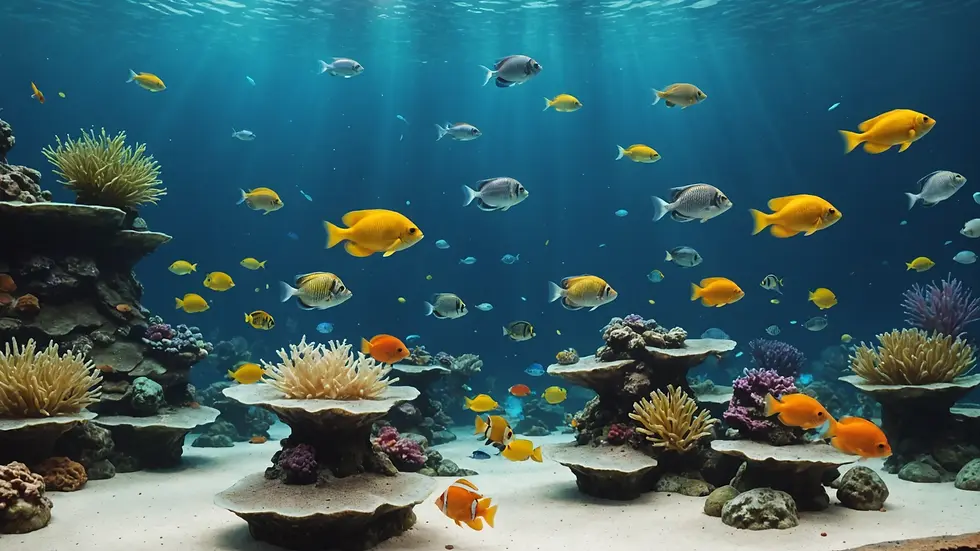Uncovering the Mysteries: A Beginner's Guide to Identifying Various Fish Species
- Jyotiraj Borah
- Feb 5
- 5 min read
Identifying different fish species may initially seem overwhelming, but it can quickly become an exciting and rewarding pursuit. The wide range of fish in our oceans, rivers, and lakes offers endless opportunities for discovery. This guide will provide practical tips and insights that will help you confidently identify various fish species.
Understanding Fish Anatomy
Before we explore specific identification techniques, it's essential to grasp the basic anatomy of fish. Understanding the features of fish will assist you in pinpointing the unique characteristics that distinguish one species from another.
Fish anatomy includes:
Head: The head holds the mouth, eyes, and gills, making it essential for feeding and breathing.
Body: The body helps with buoyancy and streamlined swimming. For instance, a sleek shape is beneficial for fast-moving species.
Fins: Fish possess different types of fins, such as dorsal, pectoral, pelvic, anal, and caudal (tail) fins. Each type serves a distinctive purpose, from stabilization to steering.
Scales: Scales come in various patterns and colors, which can contribute to your identification efforts.
By familiarizing yourself with these anatomical features, you will enhance your ability to differentiate between fish based on their shapes, sizes, and colors.
Key Features for Identification
When identifying fish, there are several critical features to consider.
1. Color Patterns
Color patterns are strong indicators of fish species. For example:
Solid Colors: Clownfish are bright orange with distinct white bands, making them easy to identify.
Stripes and Spots: The zebra danio is recognized for its horizontal stripes, while the spotted gar features unique spots along its body.
Recognizing these color traits can help you quickly narrow down potential species.
2. Body Shape
The shape of a fish's body provides important identification clues. Consider the following categories:
Streamlined: Barracuda have elongated, torpedo-shaped bodies ideal for rapid swimming. They can reach speeds of up to 36 miles per hour.
Flat: Flatfish such as flounder have bodies suited for lying on the ocean floor. Their adaptations help them blend in with their surroundings.
Deep-Body: Species like angelfish have wide, flat bodies that allow greater maneuverability in confined spaces.
Observing body shape can reveal information about the fish’s feeding habits and habitat.
3. Fin Configuration
Fin arrangements and types are crucial for species identification. Key observations include:
Dorsal Fins: Some fish, like the goldfish, have a single dorsal fin, while species like hammerhead sharks may have multiple dorsal fins, adding to their unique profiles.
Tail Fins: A forked tail indicates a fish adapted for swift movement, such as the yellowfin tuna, which can swim at speeds of up to 50 miles per hour.
Analyzing fin configurations can provide significant insights into a fish's lifestyle.
4. Habitat
The environment where a fish is found is an essential factor in identification. Fish can be found in:
Freshwater: Species such as trout and bass thrive in lakes and rivers.
Saltwater: Diverse ocean species, including tuna and marlin, indicate that you are in marine waters. For example, marlin are known for their incredible speed and can weigh over 1,000 pounds.
Brackish Water: Estuaries can host species like mullet, which adapt to both saltwater and freshwater conditions.
Understanding fish habitats greatly narrows down your identification possibilities.
Utilizing Resources for Identification
Today, there are numerous resources available to aid in identifying fish species. Here are some useful tools:
1. Field Guides
Investing in a field guide specific to your region can be incredibly beneficial. These guides often include:
Photographs: High-quality images facilitate quick identification.
Descriptive Text: Information on behavior, habitat, and characteristics provides context that aids in understanding.
Field guides are invaluable when you are out exploring nature away from mobile devices.
2. Mobile Apps
Mobile technology offers convenient access to fish identification resources. Many apps provide features like:
Picture Recognition: Some apps allow you to take a photo for immediate identification.
Community Input: Gain insights from other users who share their catches and experiences.
These apps enhance your identification experience, particularly when adventuring in new areas.
3. Online Databases
There are many online platforms available for fish research. Websites like FishBase and iNaturalist enable you to:
Search by Features: Filter possibilities based on traits like color, shape, and habitat, helping you identify species efficiently.
Join Communities: Connect with fellow fish enthusiasts and share your findings and experiences.
Online databases serve as valuable tools for broader learning.
4. Local Clubs and Workshops
Joining a local fishing club or participating in workshops can greatly improve your identification skills. Benefits include:
Hands-On Experience: Engaging in field outings will enhance your practical skills. For instance, guided fishing trips can provide direct experience with local species.
Networking Opportunities: Build connections with knowledgeable enthusiasts who can share tips and identify local fish.
These interactions foster a sense of community and shared passion for fish.
Observational Techniques
Good observational techniques are essential for effective fish identification. Keep these tips in mind:
1. Stealth is Key
Fish can be very cautious. To increase your chances of observing them, try to:
Move Slowly: Approach carefully to avoid startling the fish.
Be Gentle: Avoid splashing water as you enter or transition in the area.
Being less intrusive improves your odds of observing fish behaviors and making accurate identifications.
2. Use Binoculars
Using binoculars can extend your viewing ability, especially for surface-dwelling fish. They enhance your ability to spot:
Behavioral Traits: Observe how fish interact during feeding or schooling.
Groups: Identifying species in schools can often be easier than spotting individuals.
Binoculars help keep a respectful distance while enhancing your observational experience.
3. Take Notes
Documenting observations in a field journal enhances your learning. Consider including:
Detailed Observations: Note color patterns, shapes, and other unique features you notice while observing.
Photographs: Capture images for later reference, making it easier to correlate notes with visual data.
Maintaining a detailed journal solidifies your understanding of various fish species.
Practical Exercises for Fish Identification
Performing practical exercises can deepen your identification skills. Here are two activities to consider:
1. Fish Spotting
Dedicate time to fish spotting at local lakes or rivers with friends or family. To enhance this activity:
Create a Checklist: Develop a checklist of fish species known to inhabit the area. Include identifying features to focus your search.
Document Your Findings: Record any sightings, describing behaviors and patterns you observed.
This hands-on practice reinforces your identification knowledge in real-world settings.
2. Aquarium Visits
Visiting local aquariums allows for direct observation of numerous species. Pay attention to:
Similarities and Differences: Compare closely related species, noting their adaptations.
Feeding Behaviors: Watch how species engage with their environment to understand their habitats better.
Aquarium visits can provide a rich learning experience and showcase biodiversity.
Embrace the Adventure
Identifying various fish species can be an enjoyable hobby that enriches your connection with nature. By learning about fish anatomy, recognizing distinguishing features, and using resources available, you will improve your skills significantly.
Take pleasure in the process of exploration. Engage with your surroundings, connect with others who share your enthusiasm for the aquatic world, and enjoy each moment of discovery. Whether you are fishing or simply appreciating nature, countless fish mysteries await you. Happy fishing!







留言